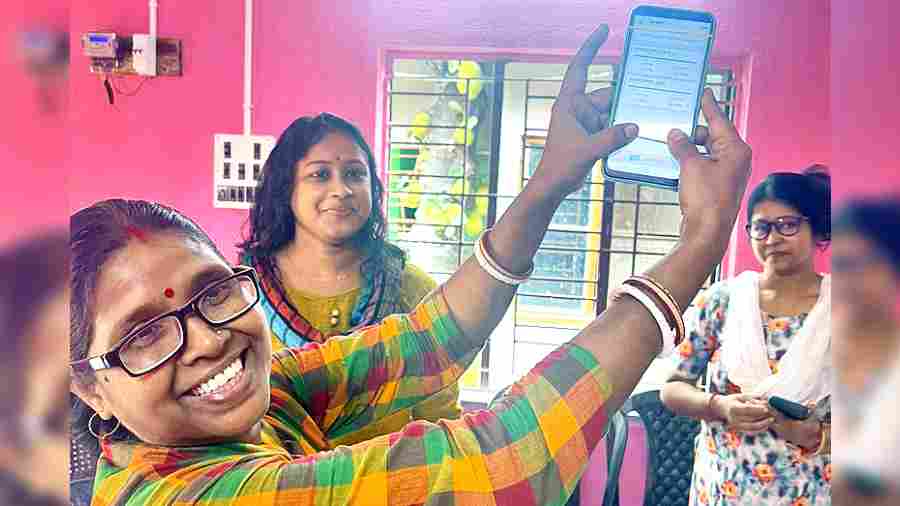Sharmiladi, 44, has connected scores of women in Attabagan, a low-income neighbourhood within Garia in south Calcutta where she lives, to various livelihood opportunities. But sometime in January 2021, she found one that required them to merely read out a text in Bengali, about 750 lines or so, into an app called Karya and get paid a thousand rupees.
Karya is a smartphone-based platform for digital micro-tasks. It was developed in 2018, in Microsoft Research Bengaluru, and spun off into a separate venture in 2021. Karya workers are present across India’s hinterland but two sisters, Saumya and Mahima Verma of the Calcutta Foundation, control the countrywide operations from their New Alipore office.
Linking up with NGOs that work in interior districts across India, the Verma sisters managed to recruit close to 20,000 “voice participants” within a year. It wasn’t easy; participants were reluctant to sign up fearing phishing attacks and misuse of personal data. Besides, for people used to being paid only for doing physical labour, digital work evoked suspicions of “easy money”. “That’s where a coordinator, like Sharmiladi, plays a vital role in getting them on board,” explains Mahima.
In the low-income, Muslim-dominated neighbourhood of Tiljala in south Calcutta, the local coordinator has assured participants that the Bengali text they read aloud into the Karya app feeds into a noble purpose of eventually educating rural children. “Because of me some child may benefit,” says 20-year-old Aslam, one of six children in a household with sporadic employment.
Two trends of Indian Internet behaviour ratify that Aslam is not entirely wrong. The first, according to a 2019 report released by KPMG and Google, is that the segment of non-metro users who speak in an Indian language is growing faster at 18 per cent than the English-speaking one in metros, which is growing at 3 per cent. In the next five years, nine out of 10 Indian Internet denizens are likely to be from the first segment.

One Karya App worker displays the app.
The second trend is that users are likely to prefer speaking in their own tongues rather than typing. This trend is so aggressive that there has been a 270 per cent year-on-year growth in voice search on the Internet in India, as per the same report. Thus, voice searches in Indian languages are going to be pivotal to the digital space.
To build such voice-enabled interfaces, machine learning has to be fed thousands of hours of voice data in Indian languages in as many intonations and variations in pronunciations as can be found. That’s where voice-data suppliers like Karya or I-merit or the Australian Appen come in. They offer the opportunity to low-income people like Aslam, who can speak a regional language, and sell the voice database to companies making products based on voice and speech recognition technology.
These companies are not just the Amazons and Googles but could be any of the zillion start-ups that have emerged in this space. Navana Tech has created an e-commerce voice bot that works on WhatsApp and allows customers and sellers to have a conversation in the local language just as they would do in a corner shop. Gnani.ai offers voice assistance to the healthcare sector. Others like Vokal and Vernacular. ai are building their automated speech engines for the next wave of Internet users.
The worldwide speech and voice technology market is expected to grow, driven by demand for voice search in ride-sharing, healthcare, banking and e-commerce sectors. E-commerce giants are particularly interested in vernacular voice interfaces to lure the digitally diffident online shopper in small towns for whom the predominance of English on websites is a barrier. To this end, Flipkart bought speech recognition company Liv.ai and Reliance acquired Reverie Language Technologies.
On a humid afternoon, a group of women who have tasted success through digital work assembled in the Garia resource centre in anticipation of more. Amazon’s Mechanical Turk, which crowdsources micro-digital tasks, claims that 35 per cent of its workers in India are women. This is because of digital work’s inherent flexibility of time and space.
Kabita Guha of the Sunderbans was keen on joining the police or the armed forces. That dream died when she got married at 22. Now, at 30, she is grateful to earn without leaving home. Voice data generation offers Mamta Ghosh, 41, extra income to make unplanned purchases for her teenage daughter. For Seema Das, 35, two rounds of work on the Karya app earned her the same as her tailoring job, but without the hip pain.
Someday, a person in a remote village of Arunachal Pradesh may be able to say “switch off the TV” in Idu Mishmi, a Sino-Tibetan language spoken in the state by a small group, and the voice assistant will follow the command. Making that happen are thousands of low-income Indians speaking into smartphones — from the slums of Mumbai to rural Nadia — and a clutch of tech companies.










